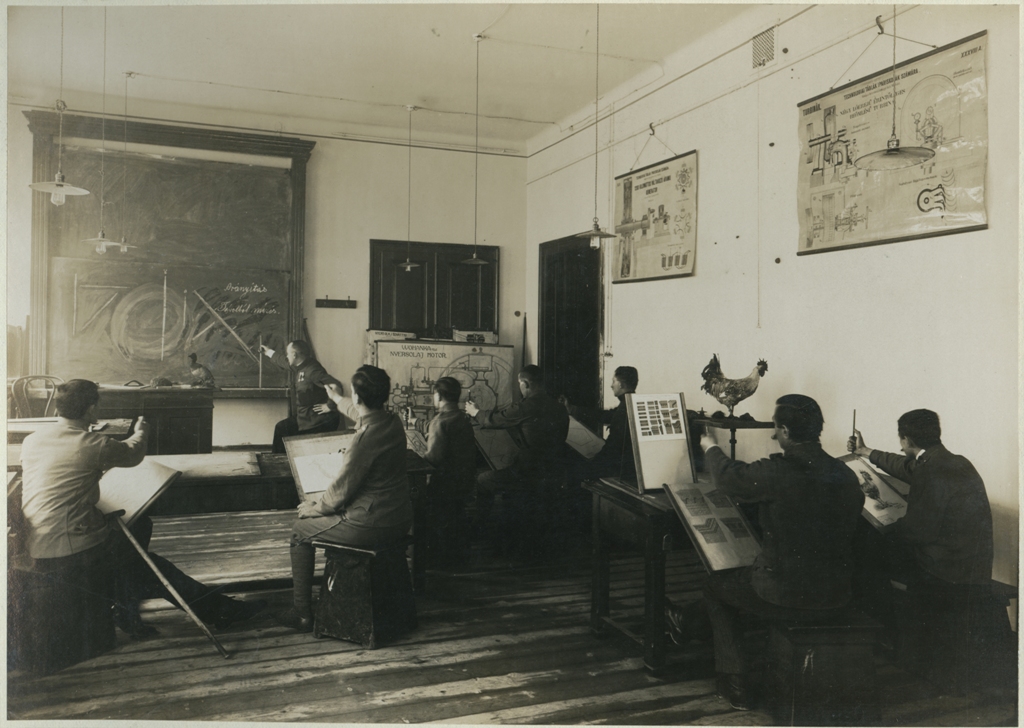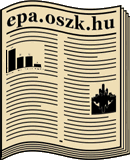A magyar iparoktatás „hadi útja”
A magyar szakképzés kihívásai az első világháború éveiben
DOI:
https://doi.org/10.15170/PAAA.2015.02.02.03Kulcsszavak:
oktatás- és neveléstörténet, iparoktatás, hadigondozás, rokkantiskolák, első világháborúAbsztrakt
The questions of modernisation and social thinking altogether determined the modification of the roles of Hungarian vocational education during World War I.
At the end of the 1890s, a modern, industrialised vocational education system was formed in Hungary. The education of qualified workmen was an integral part of the power rivalry among certain countries in this time period. The peak of this rivalry was signified by World War I, when results were also measured on the battle fields. During the war, by the sufficient appreciation of strategic goals of industrial production, vocational education had a more important role in the narrative of central power. However, because of the continuance of wars, widely new problems and tasks emerged.
The nursing and rehabilitation of injured soldiers returning home from World War I meant new challenges towards forming the idea of a “caring” government. Vocational education and the national social policy became closely linked as a result of the armaments events after 1914, which Act XV of 1915 also proves. The concept of vocational education was redefined. New types of ’industrial vocational schools’ (schools for the war invalids) appeared. Their task was not to serve market interests primarily, but to improve the living conditions of handicapped and disabled people. Old institutions also had to adapt to the changed requirements. They not only took part in military production or handed over buildings to accommodate soldiers but also latched on to the aftercare of disabled soldiers by organizing different types of courses.
This paper aims to show the history of the Hungarian vocational education during World War I, focusing on the relation between the vocational education and the rehabilitation of the injured soldiers as well as the schools for the warinvalids. The research was based on archival resources, school reports, applicable legislation, and the contemporary media. The study pays particular attention to the education structure and to the effect of the war on the hinterland and the national social policy.
Fotó: Pozsonyi Kifli
Letöltések
Hivatkozások
Antal Ákos: A Kassai Ipariskola története. Budapest, 1996.
Bódy Zsombor: Mobilitás és iskolarendszer. A felső kereskedelmi iskolák helyéről a magyar iskolarendszer társadalomtörténetében. A Budapesti Kereskedelmi Akadémia diákságának rekrutációja és mobilitása 1860–1906. In: Zsombékok. Középosztály és iskoláztatás Magyarországon a 19. század elejétől a 20. század közepéig. Szerk. Kövér György. Budapest, 2006. 757–783.
Borsi Lőrinc: Veszprém város iparoktatásának története a hazai iparoktatás tükrében. Veszprém, 2000.
Braddock, David L. – Parish, Susan L.: An Institutional History of Disability. In: Albrecht, Gary L. – Seelman, Katherine – Bury, Michael: Handbook of Disability Studies. Thousand Oaks (California), 2001. 11–68. || [DOI] https://doi.org/10.4135/9781412976251.n2
Briggs, Asa: A jóléti állam történeti perspektívában. In: A jóléti állam. Szerk. Ferge Zsuzsa – Lévai Katalin. Buda-pest, 1991. 223–239.
du Feu, Jenny: Factors influencing rehabilitation of British soldiers after World War I. Historia Medicinae, 1. (2009):2.(http://www.medicinae.org/e10) [2015.07.20.]
Ferge Zsuzsa: Fejezetek a magyar szegénypolitika történetéből. Budapest, 1986.
Fericsán Kálmán: Ősi fának ága-boga. A középszintű iparoktatás és fejlődése Magyarországon. Pécs, 1999.
Fericsán Kálmán: Tanítómesterek és mestertanítók. Buda-pest–Pécs, 2001.
Foucault, Michel: A szexualitás története I. A tudás akarása. Budapest, 1996.
Foucault, Michel: A bolondság története a klasszikus korban. Budapest, 2004.
Gyáni Gábor: A szociálpolitika múltja Magyarországon. Budapest, 1994.
Győriványi Sándor: A szakképzés története Magyarországon. Budapest, 2000.
Gordosné Szabó Anna: Gyógypedagógia-történet I. Egyetemes gyógypedagógia történet a XX. századig. Budapest, 1991.
Hegedüs Lajos: Velünk élő történelem, avagy egy érdekérvényesítő polgári jogi mozgalom mindennapjai. In: Hegedüs Lajos – Ficsorné Kurunczi Margit – Szepessyné Judik Dorottya – Pajor Emese – Könczei György: A fogyatékosságügy hazai és nemzetközi története. Budapest, 2009. 135–175.
Kálmán Zsófia – Könczei György: A Taigetosztól az esély-egyenlőségig. Budapest, 2002.
Kereszty Orsolya: Nők szerepei és terei a magyar nemzetépítésben a dualizmus kori Magyarországon. In: Képzés és Gyakorlat konferenciák I. Interdiszciplinaritás a pedagógiában. Szerk. Kereszty Orsolya. Kaposvár, 2008. 147–158.
Kereszty Orsolya: A felsőbb leányiskolák a dualizmus kori Magyarországon. In: Képzés és Gyakorlat konferenciák II. Új utak, módszerek, nézőpontok a pedagógiában. Szerk. Kereszty Orsolya. Kaposvár, 2008. 129–144.
Kéri Katalin: A katolikus elemi iskolák és tanítók helyzete Baranyában az I. világháború alatt. In: Kutatás és képzés. In honorem Orosz Gábor. Szerk. Brezsnyánszky László – Fenyő Imre. Debrecen–Nyíregyháza, 2010. 41–53.
Könczei György: Honnan ered a fogyatékossággal élő emberrel szembeni előítélet? In: Hegedüs Lajos – Ficsorné Kurunczi Margit – Szepessyné Judik Dorottya – Pajor Emese – Könczei György: A fogyatékosságügy hazai és nemzetközi története. Budapest, 2009. 175–232.
Kövér György: Iparosodás agrárországban. Budapest, 1982.
Kullmann Lajos – Kun Helga: „...El kell-e felejtenünk az orvosi modellt...? A fogyatékosság jelensége az orvostudományban. In: Tágabb értelemben vett gyógypedagógia. Szerk. Zászkaliczky Péter – Verdes Tamás. Budapest, 2004. 67–90.
Mayer, Christine: Vocational Education in Germany in a historical and gender-oriented perspective. In: Gender history of (vocational) education. Ed. Heikkinen, Anja. Hämeenlinna. Tampereen yliopiston opettajankoulutuslaitos, 1996. 29–45.
Mészáros István: Magyar iskolatípusok 996–1990. Buda-pest, 1995.
Nagy Adrienn: A kereskedelmi akadémiák helye a dualizmus kori iskolai piacon. In: Célok és módszerek a tudásalapú társadalom nevelési intézményeiben: V. Képzés és Gyakorlat Nemzetközi Neveléstudományi Konferencia. Szerk. Hajdicsné Varga Katalin. Kaposvár, 2010. 258–267.
Nagy Adrienn: Mezőgazdasági és háztartási leányiskolák Magyarországon. In: Perspektívák a neveléstudományban. Válogatás a Pécsi Tudományegyetem „Oktatás és Társadalom” Neveléstudományi Doktori Iskola kutatóinak írásaiból. Szerk. Benedek Dániel – Vadász Viola. Pécs, 2011.
Nagy Adrienn: Kereskedelmi szaktanárképzés Magyarországon. In: Iskola a társadalmi térben és időben 2011–2012. I. köt. Szerk. Andl Helga – Molnár-Kovács Zsófia. Pécs, 2013. 166–175.
Nagy Adrienn: Fiume dualizmus kori oktatásügye és a Magyar Királyi Kiviteli Akadémia. A magyarosítás és a szakoktatás kiépítése. Korall, (2014):56. 118–145.
Nagy Adrienn: A felső kereskedelmi iskolák fejlődéstörténete Magyarországon (1867–1945). Doktori értekezés. [Kézirat] Pécs, 2014. (http://www.nevtudphd.pte.hu/files/tiny_mce/Vedesek/2015/Nagy_Adrienn_PhD_2014k.pdf ) [2014.12.12.]
Nagy Péter Tibor: Szakoktatás és politika. Budapest, 1994.
Nagy Péter Tibor: Az iparpolitika és a tanoncoktatás kialakulása. In: A középfokú szakoktatás története Magyarországon a felvilágosodástól napjainkig. Szerk. Kiss Vendel – László János. Tatabánya, 1999. 16–23. (Tatabányai Múzeum Tudományos Füzetek 3.)
Nagy Péter Tibor: A magyar fogyatékosok iskolázottság-történetéhez. Iskolakultúra, 22. (2012):5. 3–13.
Németh András: Mi is az idő? – Történeti időszociológiai és időantropológiai vázlatok. Iskolakultúra Online, 1. (2007) 54–75.
Orosz Lajos: A magyarországi ipari, mezőgazdasági és kereskedelmi szakoktatás vázlatos története. Budapest, 2003.
Pajor Emese: A vak és a látássérült emberek mozgalmának magyarországi története. In: Hegedüs Lajos – Ficsorné Kurunczi Margit – Szepessyné Judik Dorottya – Pajor Emese – Könczei György: A fogyatékosságügy hazai és nemzetközi története. Budapest, 2009. 67–134.
Páldi-Kovács Attila: Ipari táj. Gyárak, bányák, műhelyek népe a 19–20. században. Budapest, 2007.
Pandur István: A barcsi iparoktatás története 1836–1986. Barcs első írásos említésének 600. évfordulója alkalmából.Barcs, 1988.
Romsics Ignác: Magyarország története a XX. században.Budapest, 2005.
Róna Árpád: A protézis technikáról és a hadi rokkantaknak az elektrotechnikai iparban való alkalmazhatóságáról. Elektrotechnika, 9. (1916):13. 109–113.
Suba János: Az Országos Hadigondozó Hivatal. A Hadtörté-neti Múzeum értesítője, (2011):12. 177–184.
Szűcs Pál: A magyar szakképzés ezre éve I. Budapest, 1996.
Székely Miklós: A magyarországi ipari szakoktatási rendszer a századfordulón, különös tekintettel Erdélyre. In: KovácsZsolt – Orbán János: Táguló horizontok. Tanulmányok a fiatal művészettörténészek marosvásárhelyi konferenciájának előadásaiból. Marosvásárhely–Kolozsvár, 2013. 129–141.
Víg Albert: Magyarország iparoktatásának története az utolsó száz évben, különösen 1867 óta. Budapest, 1932.
Vörös Katalin: „Kié a tanonc?” A kettős felügyeleti rendszer a 19. század második felének tanoncoktatásában. In: Tanul-mányok a neveléstörténet pécsi műhelyéből. Szerk. Méreg Martin – Somodi Imre – Vörös Katalin. Pécs, 2013. 55–64.
Zászkalicky Péter: A (gyógy)pedagógiai antropológia mint (gyógy)pedagógia bázisdiszciplínája. In: Tanulmányok a neveléstudomány köréből. Szerk. Kelemen Elemér – Falus Iván. Budapest, 2006. 80–99.

Downloads
Megjelent
Hogyan kell idézni
Folyóirat szám
Rovat
License

This work is licensed under a Creative Commons Attribution-NonCommercial-NoDerivatives 4.0 International License.










